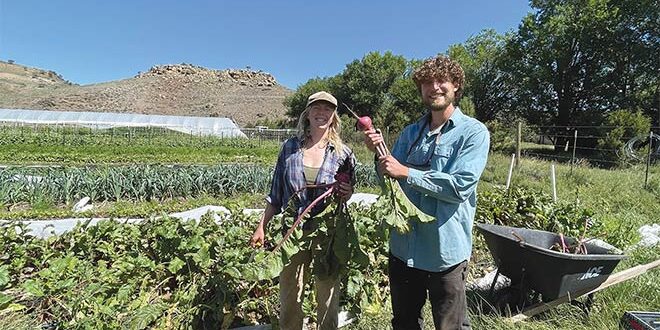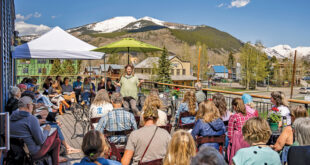“This is the time of year when most of our produce comes from our own farms”
[ By Katherine Nettles ]
It’s harvest time across Colorado and even in the high country there’s plenty of local produce to be had. Mountain Roots Food Project agriculture program director Jennifer Dews and field manager Gavin Schmuckler spoke with the Crested Butte News recently about the growing season’s ups and downs, lessons learned from year to year and the best produce to be found in the area in these late days of summer.
The Harvest Hoedown community event in Gunnison on Friday, September 9 will be the ultimate tribute to the fruits of summer’s labor with farm fresh dinner, square dancing and live music, followed by a Fermentation Fest on September 11 to help preserve a little extra summer for the colder months to come.
Mountain Roots manages farms with roughly a 1,000 foot difference in elevation between the two ends of the valley, and Dews and Schmuckler say the short growing season has not been without challenges.
From drought to floods
“Everybody had a rough start,” says Dews of the dry spring when much of the main planting happened. Mountain Roots is part of the Gunnison Valley Producers Guild, which includes eight different food producers that meet every month to combine seed orders, compare notes, share farm equipment and support one another in general with seasonal public events. Its members include Calder Farm, Iola Valley Farms, Gunnison Gardens, Parker Pastures, Mountain Roots, Gunni Gal Aquaponics, Homestead Hut and Sunny Sage Farm.
“There was basically a lot of pest pressure on the broccoli, cabbage, really all the brassicas,” says Schmuckler. That was especially difficult in the greenhouses with permanent beds, although he says they decided to replace the soil this year to reduce the number of pests overwintering.
Once the rains started showing up at the end of June, Schmuckler says things improved. “I saw in the fields that the vegetables were perking up and seeds were germinating that we didn’t think were going to,” he says.
This has been Mountain Roots’ second season farming at the Glacier Farm property in Crested Butte South, owned by the Niccoli family. Dews says they are getting used to the characteristics of the new farm, including considerations for soil health and flood management.
“Both our farms are surrounded by ranchlands, so if the fields get wet we can experience flooding of our seeds and crops,” she explains. “The Niccoli family helped us with the timing of their ditch irrigation system for flooding their fields to make sure it didn’t happen at the same time as a torrential downpour.”
Dews said there was one small flood but no crops were lost, and “We learned from last year when we lost crops to really heavy flooding.”
“Being able to communicate with them makes a difference,” says Schmuckler. Mountain Roots has acquired some covered tunnel spaces through grant funding, and for the first time was able to grow tomatoes, cucumbers, peppers, squash and basil. The tunnels extend the growing season by at least a month on either end, “And now we can plant more successions of lettuce, carrots and other cool weather vegetables,” he explains.
“We’ve had an abundant growing season although we got off to a slow start,” agrees Dews. “This is the time of year when most of our produce comes from our own farms.”
That abundance includes hundreds of pounds of carrots, thousands of pounds of potatoes, nearly 400 feet of sugar snap peas that are still maturing but have already yielded over 100 pounds, plus cucumbers, edible flowers and other “unique things that we’re really proud of,” says Dews.
The organization has harvested over 80 pounds of tomatoes and will likely keep producing them until the first frost.
The Community Farm in Gunnison will grow through November as long as the days are mostly sunny and the nights don’t freeze. That property doesn’t have a well source for irrigation, so it is mostly producing for the Mountain Roots’ community supported agriculture (CSA) farm shares, of which there are 140 this year.
The CSA will run through the first week of October, followed by a smaller fall CSA combining harvests from the Producer’s Guild. That tends to include a lot of potatoes, garlic and onions. And radishes and turnips are usually in the mix.
Dews says the next step is finding a root cellar for cool, dry storage to prolong tomatillo and root veggie storage. “It’s something that we’re all kind of ready for,” and she says people get tired of having so many of the same things at once.
“We’ve definitely scaled back on turnips in response to our customers. But root vegetables tend to grow well here so we’re inclined to grow them,” says Dews. “We don’t want to work against nature.”
For those in the harvest spirit, there is a Fermentation Fest on September 11 to teach ‘cottage food skills’—and it also includes a farm to table luncheon.
“With such a long winter, being able to preserve the food you grew in the fall is really great,” says Dews. And for anyone whose gardens went really big this summer, consider donating the extras to Mountain Roots’ Backyard Harvest program.
For more information about Mountain Roots or the Producer’s Guild visit www.mountainrootsfoodproject.org or www.gvpg.org
 The Crested Butte News Serving the Gunnison Valley since 1999
The Crested Butte News Serving the Gunnison Valley since 1999




